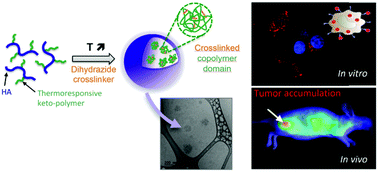当前位置:
X-MOL 学术
›
Biomater. Sci.
›
论文详情
Our official English website, www.x-mol.net, welcomes your feedback! (Note: you will need to create a separate account there.)
A versatile method for the selective core-crosslinking of hyaluronic acid nanogels via ketone-hydrazide chemistry: from chemical characterization to in vivo biodistribution†
Biomaterials Science ( IF 6.6 ) Pub Date : 2018-06-06 00:00:00 , DOI: 10.1039/c8bm00396c Francielle Pelegrin Garcia 1, 2, 3, 4, 5 , Marlène Rippe 1, 2, 3, 4 , Mychelle V. P. Companhoni 5, 6, 7, 8, 9 , Talitha Fernandes Stefanello 1, 2, 3, 4, 5 , Benoit Louage 10, 11, 12, 13 , Simon Van Herck 10, 11, 12, 13 , Lucie Sancey 4, 14, 15, 16 , Jean-Luc Coll 4, 14, 15, 16 , Bruno G. De Geest 10, 11, 12, 13 , Celso Vataru Nakamura 5, 6, 7, 8, 9 , Rachel Auzély-Velty 1, 2, 3, 4
Biomaterials Science ( IF 6.6 ) Pub Date : 2018-06-06 00:00:00 , DOI: 10.1039/c8bm00396c Francielle Pelegrin Garcia 1, 2, 3, 4, 5 , Marlène Rippe 1, 2, 3, 4 , Mychelle V. P. Companhoni 5, 6, 7, 8, 9 , Talitha Fernandes Stefanello 1, 2, 3, 4, 5 , Benoit Louage 10, 11, 12, 13 , Simon Van Herck 10, 11, 12, 13 , Lucie Sancey 4, 14, 15, 16 , Jean-Luc Coll 4, 14, 15, 16 , Bruno G. De Geest 10, 11, 12, 13 , Celso Vataru Nakamura 5, 6, 7, 8, 9 , Rachel Auzély-Velty 1, 2, 3, 4
Affiliation

|
The development of biopolymer-based nanogels has gained particular interest to achieve successful delivery of therapeutics for the treatment of various diseases, such as cancer, infection and diabetes. Herein, we report a new and simple methodology for the covalent stabilization of self-assembled gel nanoparticles based on hyaluronic acid (HA) modified with a thermoresponsive ketone-functional copolymer. This relies on the selective formation of hydrazone crosslinks with bishydrazides within the globular domains of the copolymer chains formed above the cloud point temperature. This approach allows tuning of the crosslinking density by varying the dihydrazide crosslinker to ketone molar ratio. The size distributions and morphology of the nanogels were assessed using dynamic light scattering (DLS), cryo-transmission and scanning electron microscopy. In vitro cellular uptake in several cancer cells and in vivo biodistribution of the nanogels in different mouse tumor models were then explored to assess the effectiveness of this crosslinking strategy. The data from these experiments show prolonged blood circulation, longer than 24 hours, for the crosslinked nanogels and high tumor accumulation.
中文翻译:

透明质酸纳米凝胶通过酮-酰肼化学选择性核心交联的通用方法:从化学表征到体内生物分布†
基于生物聚合物的纳米凝胶的开发引起了人们的特别兴趣,以成功交付用于治疗各种疾病(例如癌症,感染和糖尿病)的治疗剂。在这里,我们报告了一种新的和简单的方法,用于基于用热敏性酮官能共聚物改性的透明质酸(HA)的自组装凝胶纳米颗粒的共价稳定化。这依赖于在浊点温度以上形成的共聚物链的球状区域内与二酰肼选择性形成formation交联。该方法允许通过改变二酰肼交联剂与酮的摩尔比来调节交联密度。使用动态光散射(DLS),低温透射和扫描电子显微镜对纳米凝胶的尺寸分布和形态进行了评估。然后研究了在几种癌细胞中的体外细胞吸收以及纳米凝胶在不同小鼠肿瘤模型中的体内生物分布,以评估这种交联策略的有效性。这些实验的数据表明,对于交联的纳米凝胶,血液循环时间长于24小时,且肿瘤的累积较高。
更新日期:2018-06-06
中文翻译:

透明质酸纳米凝胶通过酮-酰肼化学选择性核心交联的通用方法:从化学表征到体内生物分布†
基于生物聚合物的纳米凝胶的开发引起了人们的特别兴趣,以成功交付用于治疗各种疾病(例如癌症,感染和糖尿病)的治疗剂。在这里,我们报告了一种新的和简单的方法,用于基于用热敏性酮官能共聚物改性的透明质酸(HA)的自组装凝胶纳米颗粒的共价稳定化。这依赖于在浊点温度以上形成的共聚物链的球状区域内与二酰肼选择性形成formation交联。该方法允许通过改变二酰肼交联剂与酮的摩尔比来调节交联密度。使用动态光散射(DLS),低温透射和扫描电子显微镜对纳米凝胶的尺寸分布和形态进行了评估。然后研究了在几种癌细胞中的体外细胞吸收以及纳米凝胶在不同小鼠肿瘤模型中的体内生物分布,以评估这种交联策略的有效性。这些实验的数据表明,对于交联的纳米凝胶,血液循环时间长于24小时,且肿瘤的累积较高。



























 京公网安备 11010802027423号
京公网安备 11010802027423号